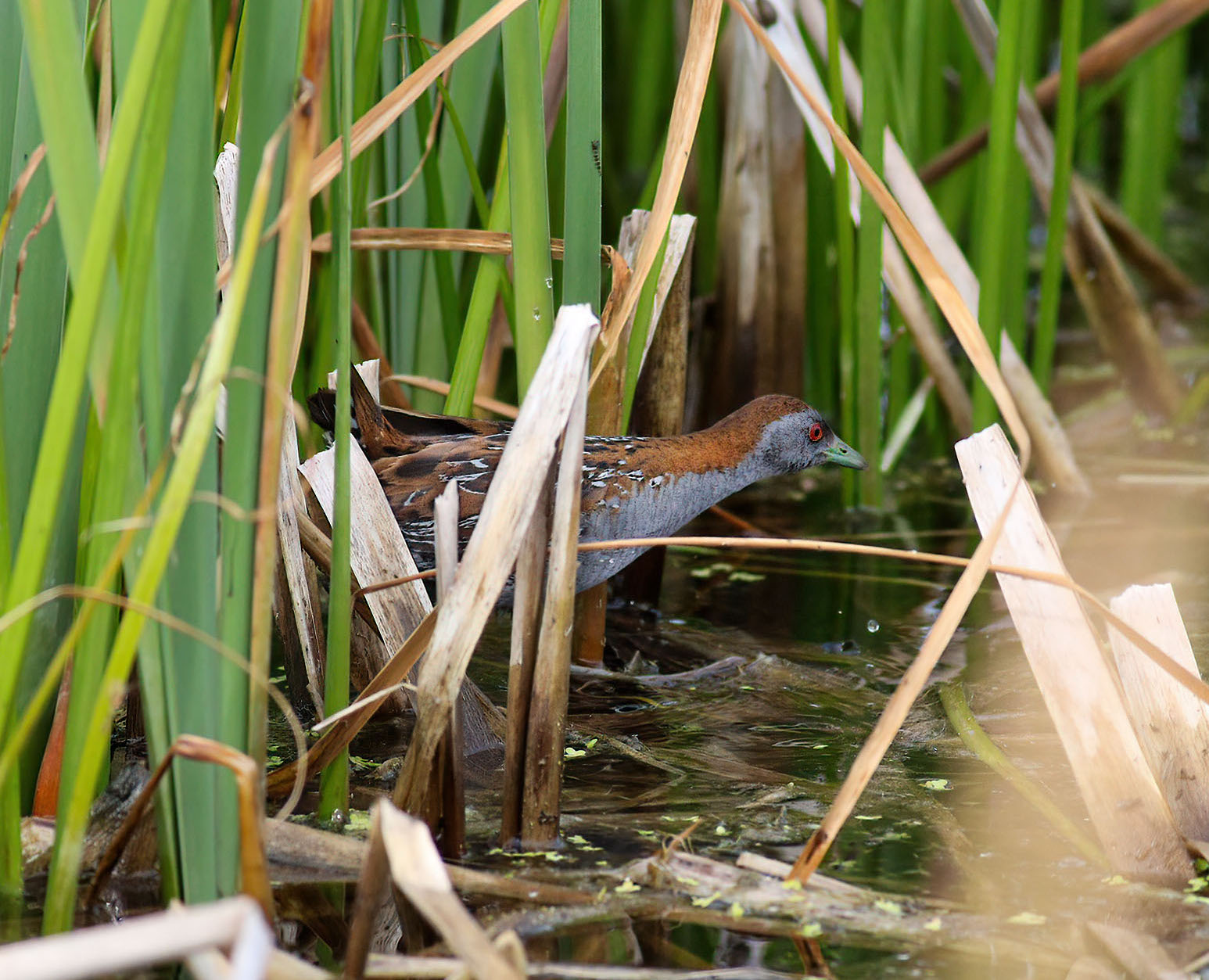Baillon's Crake Zapornia pusilla
Vagrant. Europe.

Adult male Baillon's Crake, June 5th 2022, Alkborough Flats (Neil Drinkall).
The 'Finder's Report' by Wayne Gillatt appears in full in the 2021 Lincolnshire Bird Report and is paraphrased here. An exceptional find by two of Alkborough Flats regulars who had been waiting for a mild still night in order to try and capture a recording of a Spotted Crake, Porzana porzana:
"I arrived on site at 21.00 hrs, June 5th, and set up my recording equipment in an area of wet grazing fields bordered by ditches overgrown with Phragmites reed, an area where a Spotted Crake had been recorded in 2020. Shortly after 22.00h an unfamiliar call was heard close by, best described as a little repeated rattle. A small duck took flight and, in the twilight, I could just see that it was a drake Garganey; further on it or another male Garganey was calling. At approximately 23.15 hrs another rattling call was heard about 100 meters away, initially thought to be another Garganey. The call was loud and continued non-stop with just 2-3 second intervals between rattles and the bird was clearly stationary; it was instantly recognisable and I quickly listened to recordings on https://xeno-canto.org/ out of earshot of the bird. Little Crake Zapornia parva was quickly excluded, but on playing Baillon’s Crake I instantly realised that this was what was calling. A short recording was made on my iPhone and later, a better quality recording on a proper recorder. A message was quickly sent to a friend at 23.50 hrs to say “Baillon’s Crake calling on flats now”; he called me back shortly after, half asleep, from nearby Alkborough village, but it still took some time convincing him that I was not fooling around and that he should really come down and have a listen. I made my way back to the bird and obtained some more recordings before my friend turned up. It had turned 01.00 hrs by this time and the bird just carried on calling without a break with just a Reed Warbler Acrocephalus scirpaceous singing in the background. After a short break for sleep we were back on site a little after 04.00 hrs. The bird was still calling non-stop but was now joined by other species as the dawn chorus began to break. As daylight broke, the bird was still calling from a small isolated circular clump of Phragmites surrounded by rank wet grass and some clumps of Juncus rush. The bird called a bit more intermittently as it got lighter and shortly after we realised the bird had left the clump of reeds, crossed the flooded footpath, and moved into an overgrown ditch where we managed to glimpse the bird as it moved through the vegetation. A few more views of the bird, which was now calling very infrequently, were had up to 09.00 hrs when we left. We paid a short visit on June 6th from 18.30 through to 21.30 with no sight or sound of the bird, but on June 7th, 04.00 - 08.00 hr. we had glimpses of the bird crossing the footpath from the small reedbed to the ditch and some intermittent calls. This was the last time the bird was seen or heard despite several more visits over the next two weeks".
A locally common breeder from Spain eastwards through Mediterranean Basin to Ukraine, occasionally north to the Netherlands with an estimated 980-1,400 calling or lekking males, equating to 2,000-2,800 mature individuals or 3,000-4,200 individuals. Baillon's Crakes have an exceedingly large global range and the breeding range extends eastwards across Asia to China and there are also resident breeding populations in Africa and Australasia (BirdLife International 2022). Most European birds probably overfly North Africa and winter in sub-Saharan areas. More than 80 have been recorded in the UK to date and the species bred in the UK in 2012, when there was a small influx of at least six calling males although breeding was not proven. The sole Lincolnshire record seems likely to have been an overshooting European bird.
| Site | First date | Last date | Count | Notes |
| Alkborough Flats | 05/06/2021 | 07/06/2021 | 1 | June 5th & 7th only; adult male, videoed & sound recorded |
References
BirdLife International (2022) Species factsheet: Zapornia pusilla. Downloaded from http://www.birdlife.org on 13/09/2022.
Holling, M. and the Rare Birds Breeding Panel (2014). Rare breeding birds in the United Kingdom in 2012. British Birds 107(9): 504-560.
(Account prepared September 2022)

